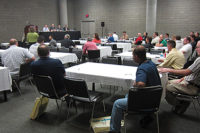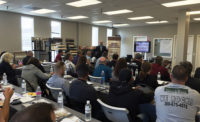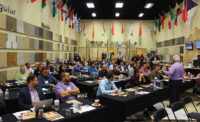For the first time in years, a Stone Summit, which is part of the Stone Industry Education Seminar program run by the MIA+BSI and Stone World magazine, was held in Birmingham, AL. The July 14, 2016 event was hosted by Pacific Shore Stones, and drew in fabricators and other members of the stone industry from surrounding states.
GK Naquin of Stone Interiors led the morning discussion by going over the stone matrix. “I know there’s always tension between sales people and production people,” said Naquin. “But issues happen. We will never get rid of them, but we should embrace them. We need to set expectations for the customer right away. This not only goes for how a stone looks or acts, but also for how long a project may take.”
Naquin told the audience that a matrix needs to be kept to measure their performance in a shop. “If a product takes longer to cut, takes longer to install or wears your tools faster, don’t be afraid to raise the price,” he went on to say.
When it comes to making profits, Naquin pointed out that it’s important to know what your expenses are. “Installation is always going to be human driven,” said Naquin. “We are always going to need people to install the countertop. The rest of the shop though is becoming more automated. The technology is continuously getting better, and we need to adapt to it to help lower our costs.
“Marble is a product that we can get for a good price and we can make a good profit on it,” he went on to say. “But in order to do that, you have to know what your costs are. Personally, the market creates my sale price. We use the matrix to figure out how to make a profit and still remain competitive.”
When it comes to employees in the shop, their salary isn’t the only expense. “You have to know how much an employee costs your company past their salary,” said Naquin. “There are different taxes. There is workman’s comp, social security, etc. Also, you have to track their hours, make sure that overtime is justified if you’re going to be paying them time and a half.
“Employees are not the only people who take time off or get sick,” he continued. “Your machines take time off too. Your machines get sick. You need to factor in those costs. Machines will breakdown eventually, and they will take time to repair. That’s the same as an employee getting sick or taking time off. You must factor that into your costs and be prepared for that to happen.”
Afternoon session
After lunch, the group took a tour of the Pacific Shore Stones facility to see the different slabs they have in stock and what has been selling recently. Following the tour, everyone broke into three different groups: one for fabrication, one for sales and one for administrative. The three groups discussed different issues that have come up during the job in their respective field.
The business administrative section discussed topics such as safety in the shop for employees and for customers, how to keep employees and recruit new ones, what incentives to give employees and how to give them the best 401k options for their retirement, if you let customers walk through the shop, and if so, how do you handle it, and lastly discussed was about OSHA raising its fines on shops.
For sales, the group discussed how to market and get your business’ name out there, how to strum up business and compete in the local market, how to use social media effectively, how to build the best website or to improve it, and finally, how to train sales employees.
The product group discussed production schedules and what to do if your shop is overbooked, how to cut different materials on the market and what tools they use in their shop on a regular basis.
After the groups finished their discussions, they joined back together to give a quick overview of what each group discussed. Naquin and the MIA+BSI then discussed the changes with OSHA and how they are raising the fees they are imposing on shops and how to deal with OSHA coming to your shop.
Lastly, Naquin discussed the new rules that President Obama had the Department of Labor update. “These are still fairly new changes and lawyers are still reading through them to make sure it is grasped completely, but essentially, it makes everyone an hourly employee,” said Naquin. “Back in the day, you were an hourly employee or salary. When you were a salary employee you could be exempt or non-exempt. That no longer exists. Salaried employees, up to a certain threshold, need to be paid time and a half if they work more than 40 hours a week. While we are still looking into it, and it’s a newer law, it’s something you need to pay attention to.”







